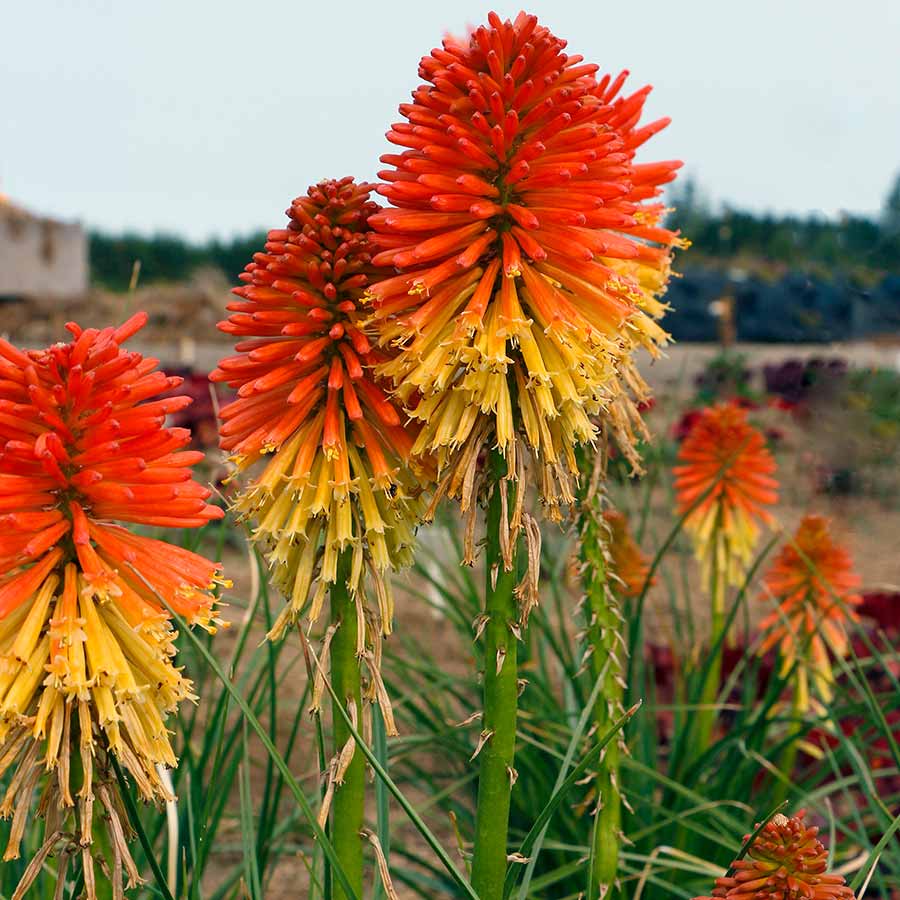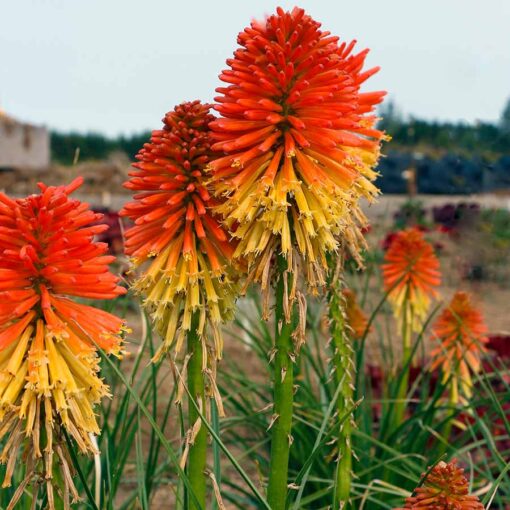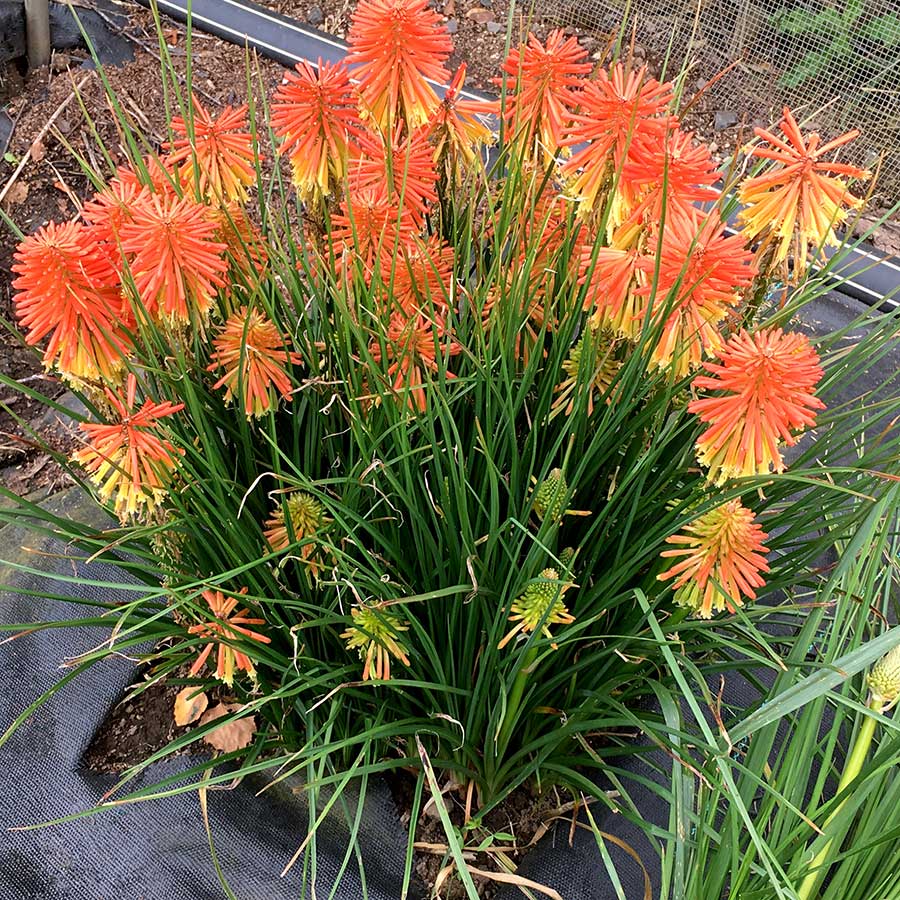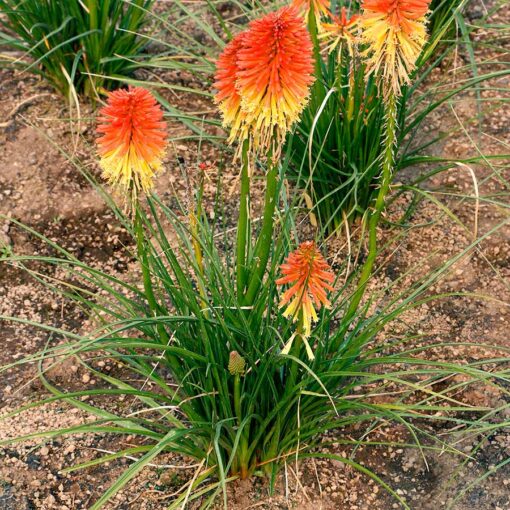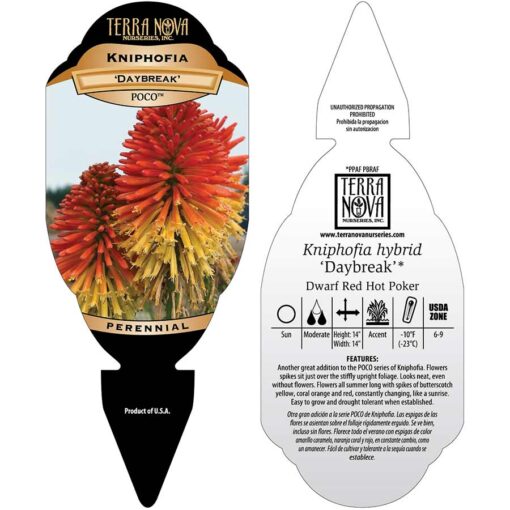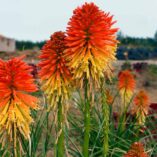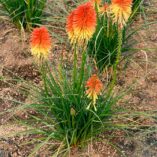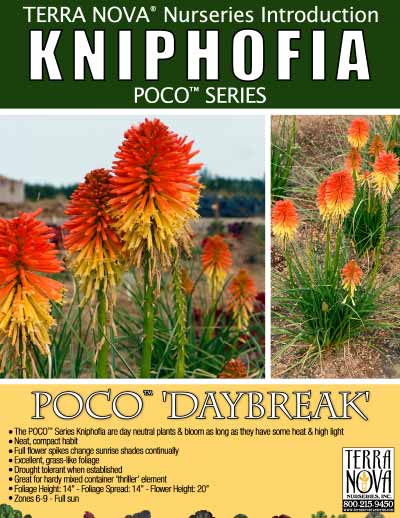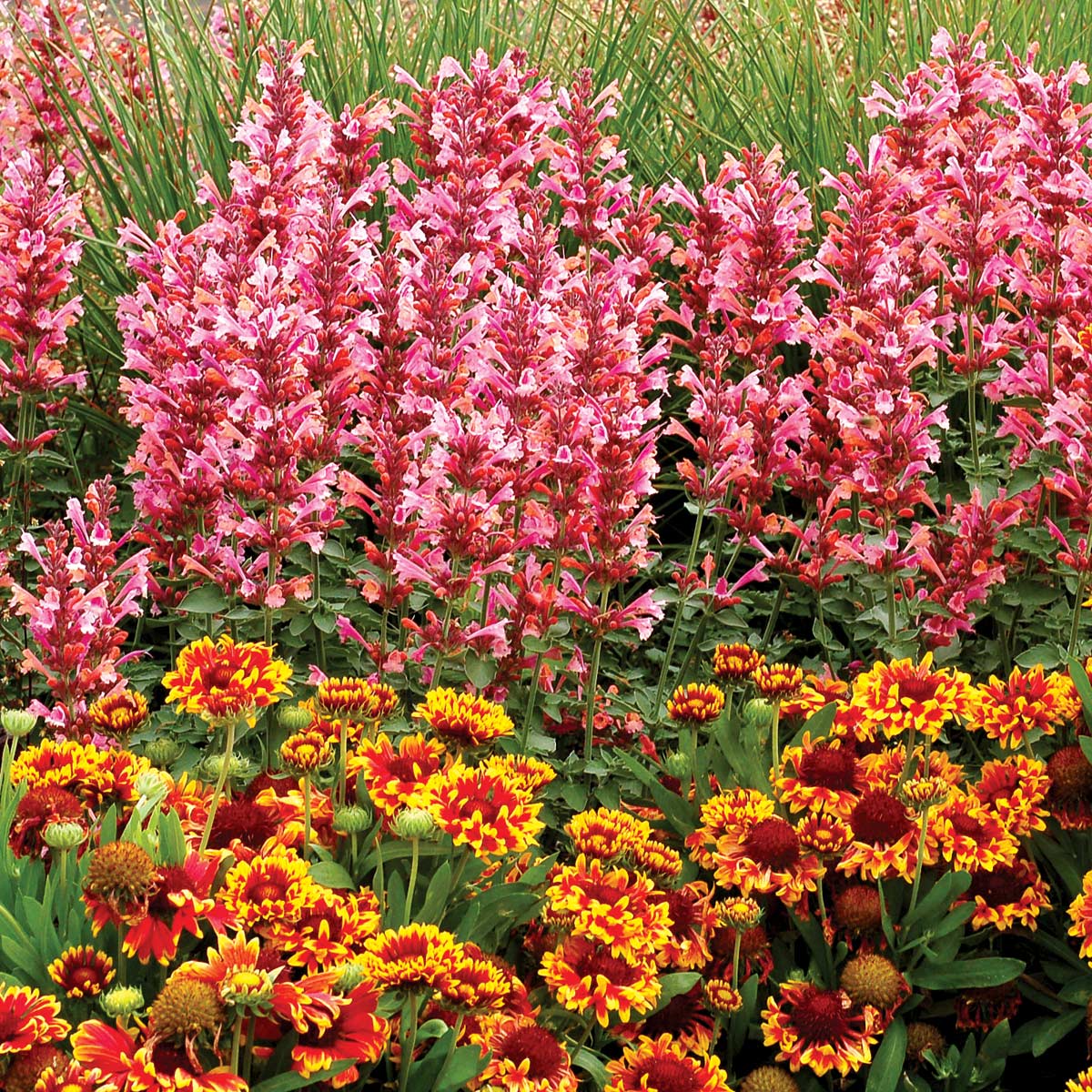| Common Name | Dwarf red hot poker |
|---|---|
| Family | Asphodelaceae |
| Genus | Kniphofia |
| species | -- |
| Plant Series | Kniphofia POCO™ Series |
| Plant Type | Perennial |
| US Patent # | PP35877 |
| EU Grant # | PBRAF |
| Bloom Time | June, July, August, September, October |
| Flower Color | Orange, Yellow |
| Foliage Color | Green |
| Dormancy | Winter |
| Exposure | Full Sun |
| Growth Habit | Clumping |
| Growth Rate | Fast |
| Hardiness Zone | 6, 7, 8, 9 |
| How Different? | A unique color combination with excellent foliage. |
| Landscape Value | A summer bloomer. Use as a color spot, in mass plantings or as a vertical accent. |
| Most Active Growing Season | Summer |
| Persistence | Deciduous |
| Size (HT/W/FL HT) | 14" / 14" / 20" |
| Soil (Garden) | Average |
| Water (Garden) | Average |
| Special Uses | Cut Flower, Deep South, Deer Resistant, Hummingbird Attractor, Low Water Usage |
| Comments | -- |
Kniphofia POCO™ ‘Daybreak’
Another great addition to the POCO™ Series of Kniphofia. Flowers spikes sit just over the stiffly upright foliage. Looks neat, even without flowers. Flowers all summer long with spikes of butterscotch yellow, coral orange and red, constantly changing, like a sunrise. Easy to grow and drought tolerant when established.
USDA Hardiness Zone(s): 6-9
Size (HT/W/FL HT): 14″ / 14″ / 20″
Exposure: Full Sun
Bloom Time(s): June, July, August, September, October
| Water (Greenhouse) | Dry moderately between waterings. |
| EC | 1.0 |
| pH | 6.0 – 6.8 |
| Fertility Needs | 150 – 200 ppm |
| Notes | The POCO™ Series Kniphofia are day neutral plants and bloom as long as they have some heat and high light. |
| Finish Time to 4″ | 4 – 6 weeks |
| Finish Time to Gallon | — |
| Day Length for Flowering | Day Neutral |
If you’re looking to add something exotic to your landscape, then look no further than Kniphofia! Also known as Torch Lilies or Red-Hot Pokers, these plants form substantial, grassy clumps with towering flower spikes that are irresistible to hummingbirds and butterflies. Beyond being super easy to grow, these beauties can also manage drought, although they tend to bloom more profusely with supplemental water.
Planting
Plant your Kniphofia roots in an outdoor location with well-drained soil that receives full or partial sun. If you notice puddles of water 5-6 hours after a hard rain, scout out another site or amend the soil with organic material to raise the level 2-3 inches. While these plants aren’t particularly fussy, they will not survive in soggy conditions or standing water. Spring is the best time to plant Kniphofia roots in the garden, as they produce flowers for several weeks in the summer and go dormant in the winter. You can expect roots to begin to grow and top growth to become evident within just a few weeks of planting.
Culture
Light: Plant blooms best in full sun, but tolerates light afternoon shade in hot climates.
Soil: Tolerant of many soil types, but doesn’t grow well in poorly-drained soil that stays soggy after watering or rains, especially in winter. They grow best in moist, compost amended soils that have a neutral or slightly acidic pH. Once established they can tolerate drier soils.
Spacing: 18 to 24 inches apart.
Watering: Although established red hot poker plants can withstand dry periods in summer, lack of adequate watering will cause the flowering to be decreased. Provide red hot poker plants with 1 inch of water every week during hot summers. Make sure the water saturates the soil 5 to 6 inches deep each time, but let the soil dry out between waterings.
Fertilizer: Amend the soil at planting with a 2-3 inch thick layer of compost. Each spring thereafter, apply a dry granular, balanced, organic fertilizer.
Pruning: Deadhead spent flowers in summer as they fade to encourage more flower stalks to form. If left to go to seed, the plant will slow down new flower production. Cut blooms at any time for indoor flower arranging. In late fall in warm areas, tie the leaves into a canopy over the crown to prevent water from accumulating in the center of the plant in winter. The water can cause the crown to rot. In early spring, cut the foliage back to 3 inches off the ground to clean up the plant and allow new foliage to emerge. In cold locations, cut back the foliage in late fall instead.
Provide supplemental water as needed in the spring and summer, with about 1" of moisture per week, although Kniphofia can tolerate less water once established.
Cut down flower spikes but leave the foliage in place after blooming has finished for the season. The leaves will gather sunlight to create food through photosynthesis, strengthening the plant for the future.
Remove the dry foliage when the leaves turn yellow and die back in the fall; some varieties are evergreen or semi-evergreen in warmer climates.
Allow the plants to rest and the soil to dry out for a few months before beginning the next growing cycle in the spring.
Amend the soil with finely ground bark, decomposed manure, or compost to improve drainage and encourage a healthy start.
Opt to plant your Kniphofia in the ground rather than containers, as the mature plants grow into large clumps that often measure 2 to 3′ across.
Expect the rhizomes you receive to have roots attached, making it easy to determine which end should face upwards.
Enjoy the spectacular flowers, snipping a few for striking arrangements, as doing so will not hurt your plants and will actually encourage the production of more blossoms.
Divide clumps of Kniphofia every 4 to 5 years. In cold-winter regions, divide the plants in spring. In warmer climates, divide them after they finish blooming.
What are alternatives to red hot poker plants?: Gaillardia, also known as blanket flower, is a great alternative to red hot poker, especially in areas where red hot poker is considered invasive.
Can red hot poker grow indoors?: Dwarf varieties of red hot poker can be grown indoors. Keep in mind that these plants will need regular division to stay healthy in pots, and you might not get as many blooms as you would if the plant were outdoors.
Can I grow kniphofia in a container?: Larger varieties are not suitable for containers, but smaller ones are fine.
Can I use kniphofia as a cut flower?: Yes, kniphofia is very striking in arrangements.
Does kniphofia attract pollinators?: Yes, kniphofia attracts hummingbirds and butterflies.
Is kniphofia deer resistant?: Yes it does tend to be deer, as well as rabbit, resistant.
What do I do after my kniphofia blooms?: It doesn’t look very good. After your plants bloom remove the flower stalks, and also cut back the foliage by about half for a neater appearance.
How long can red hot poker live?: This plant needs to be divided every three to five years. Letting a plant grow without division during this time can lead to the death of the plant.
All photography is property and © of TERRA NOVA® Nurseries, and is only to be used for promotional material related to TERRA NOVA® products.
Please credit TERRA NOVA® Nurseries in the following manner:
Photo(s) courtesy of TERRA NOVA® Nurseries, Inc.
www.terranovanurseries.com
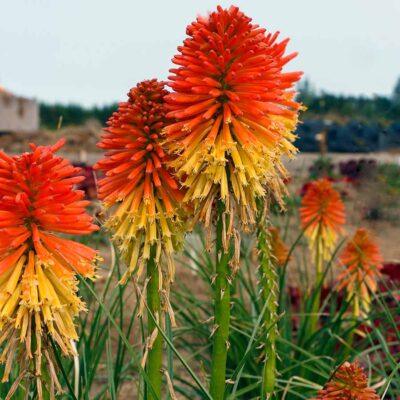  |
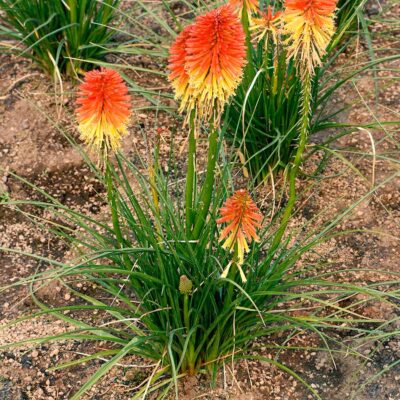  |
  |
Our tags are produced using Adobe Illustrator (.ai) format.
  |
Get the latest FREE version of Acrobat® Reader™
here.- May, 2023 – Garden Smart: Some Cool Pokers That Are Hot! – click here

